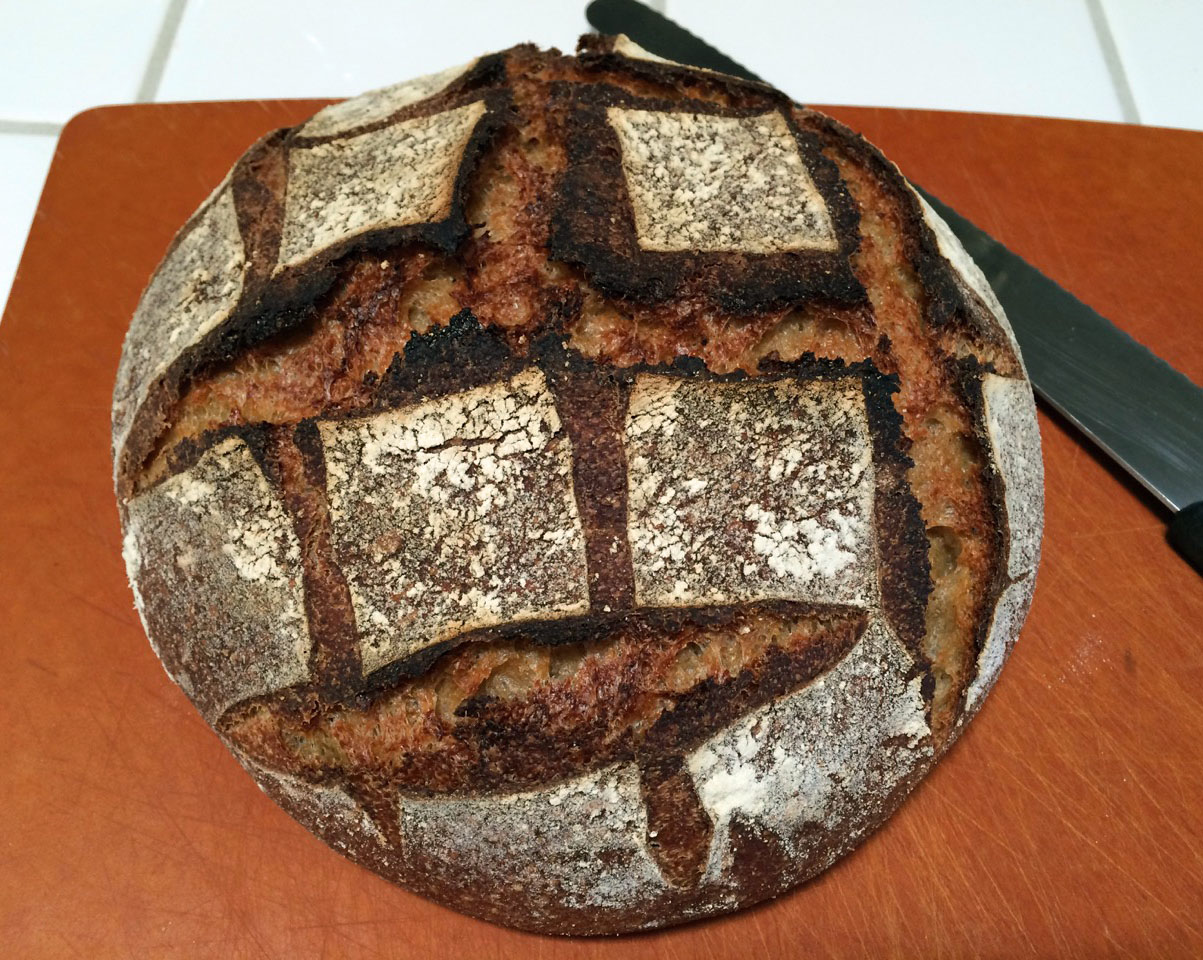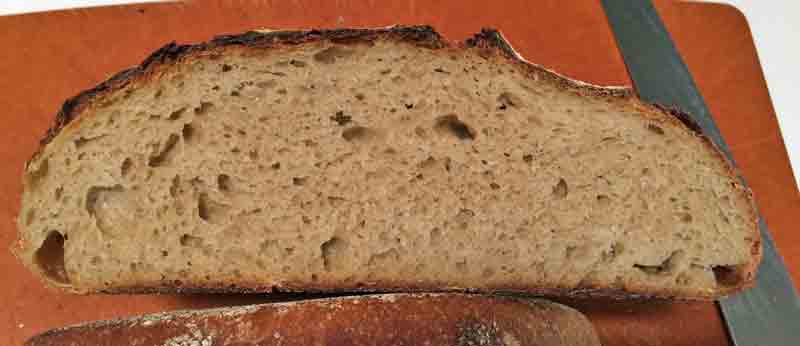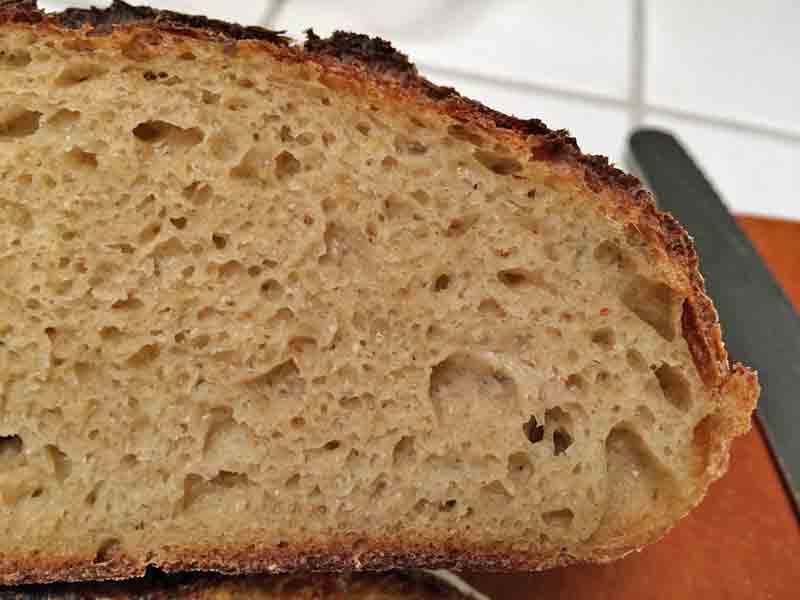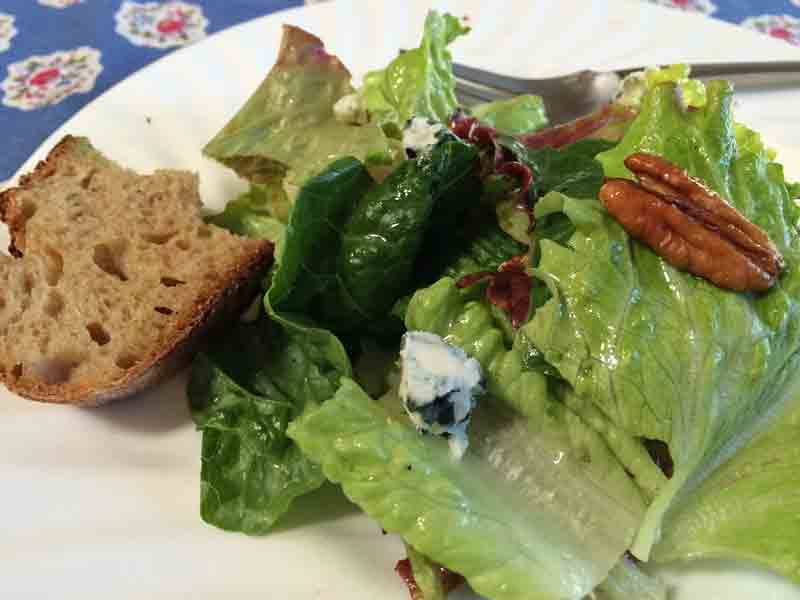
60% Kamut Sourdough Bread from "Tartine Book No. 3"

This is my first venture into baking with Kamut. It won't be my last. Kamut is a copyrighted name for Khorasan wheat which is an "ancient grain" - one of the ancestors of modern durum wheat. Like durum, it is a large berry that is yellowish in color and, when used in high percentages, gives a yellowish color to the bread's crumb. It is claimed that individuals who cannot tolerate the commonly available modern hybrid wheat can tolerate breads made with ancient grains (eikorn, emmer, khorasan).
Kamut is very high in protein, but not in gluten. It absorbs a lot of water, particularly when used as a whole grain flour. The resulting dough benefits from high hydration and from a longer than normal autolyse.
This bread is said to be 85% hydration. In fact, because Chad Robertson does not account for the water in his liquid starter when calculating baker's percentages, the hydration is a bit higher. This dough is 60% whole grain Kamut. (I used freshly milled flour.) It also calls for another 20% high-extraction flour. (I used Central Milling's T85 Organic flour). Yet, the dough was delightful to handle. It was tacky but not sticky and very extensible. The loaf's crumb is airy, light, cool and tender. The flavor when freshly cooled was not very different from a bread made with common red hard Winter wheat, to my taste. My experience with similar breads is that their flavor evolves over the first 2 or 3 days, though. So, we'll see.
How about some photos?



The bread was very nice for lunch with a lettuce salad with Point Reyes blue cheese, toasted pecans and comice pear.

When I was working on my Pane di Altamura, I made several loaves with 100% fine durum flour and a durum-fed starter. I plan on trying a bread with 100% Kamut. I'm thinking a Greek Pan di Horiadeki.
Happy baking!
David


Comments
i love kamut. I have been finishing all my Breadtopia flours and will be milling my grains as soon as I get through my storage. I just made a fig/date bread with a large amount of kamut. It was wonderiful with cheese. Look forward to the New Year and baking discoveries. Happy Baking David
I've never used Kamut, but that loaf makes me want to try it! Gorgeous.
breads but she rarely specifies more than 20% in any loaf. It tends to spread more than elevate and gets worse the wetter the dough. We just love the color though. Your example is a perfect example.
There seems to be some confusion about whether Kamut or Khorasan is an 'ancient' grain. I was reading somewhere that, through modern DNA testing, it turns out that Kamut is a cross between durum and another grain so durum had to come first - not the other way around. But, just saying it is 'ancient' has to make the sales better I am sure.
I don't think that durum is an ancient grain like emmer either but all of these terms, like 'ancient' are really marketing tools like 'artisan' bread. Emmer is just considered ancient because it was supposedly found in the tombs of pharaohs. Even that was only 5-6000 years ago and grains were around a long, long time before the Pharaohs. Ancient is what ever someone calls it I guess. I'm thinking real ancient has to be at least from the time of the dinosaurs - 150 million years ago - or from the time of disco music if you talk to my daughter:-) Still, it is nice to have all the grains we do have around today and that folks are trying to bring back the older hybrids as well.
Nice baking David as usual and Happy Holidays to you and yours.
Greetings,
Loved reading about your recent bread adventures. It has been years since I have been on the site. I have always been a silent lurker. Now I am back and ready to ask lots of questions because baking with my MockMill flour is a whole new game.
You mentioned tweaking Forish’s formula. You said you liked the original blend. I wasn’t sure if you meant Ken’s or one of your own adaptations with Kamut? Do you have a current blend you could share with me? I love all the new, fresh possibilities and millimg with the Movkmill can’t be beat.
Cheers,
Anne
Hi, Anne.
I am still in the process of playing with different blends of fresh-milled flours myself. So far, the grains I am using are red winter wheat, rye, spelt and kamut.
The "original blend" is Ken Forkish's "Field Blend #2. It is 70% AP, 17.5% whole rye, 12.5% whole wheat. I find this about perfect. I can't say any other blend yields a flavor I enjoy more. But, you know, I enjoy experimenting, and I haven't made any "bad" breads yet. Here are some of the parameters I've played with:
1. Vary the total fresh-milled, whole grain percentage. I have enjoyed breads with 30 to 100% whole grains, but my favorites have been in the 30 to 40% range.
2. Vary the grain blends. I have generally used AP or Bread flour (11.5-13.5% protein) as the base and kept the whole wheat at 12.5% (baker's percentage). Beyond that, I have been playing with whole rye, whole spelt and whole kamut in various proportions.
3. When I use more than 30% whole grain flours, I think I prefer to increase the hydration a bit. A longer autolyse also seems to make sense, because whole grain flours absorb more water.
One conclusion so far: Eliminating the rye altogether results in a less interesting flavor, to my taste. This is the re-discovery of something I first learned some 15 years ago. But, since rye doesn't really have gluten, higher percentage rye doughs develop less strength.
Stay tuned. My experimentation varying grain blends is ongoing. Why don't you join in and share your findings? In my opinion, TFL is all about the members learning from each other.
Happy baking!
David